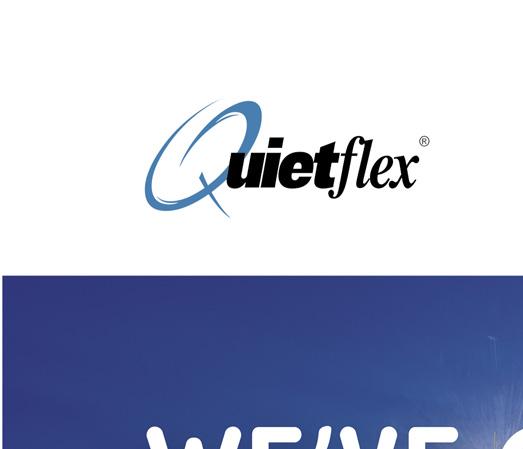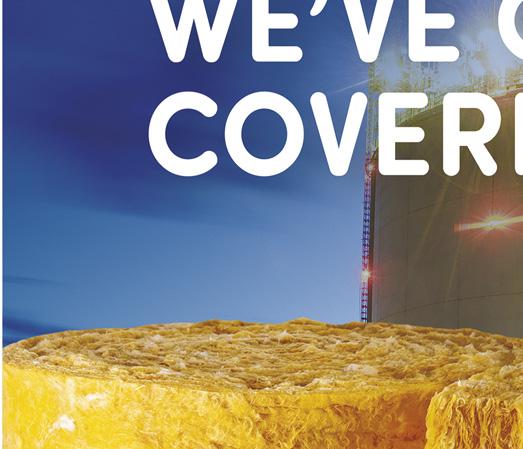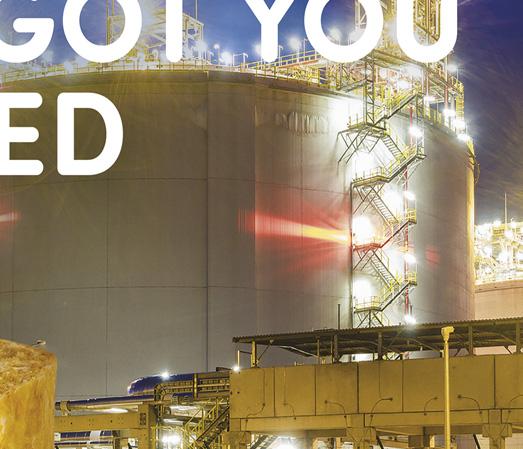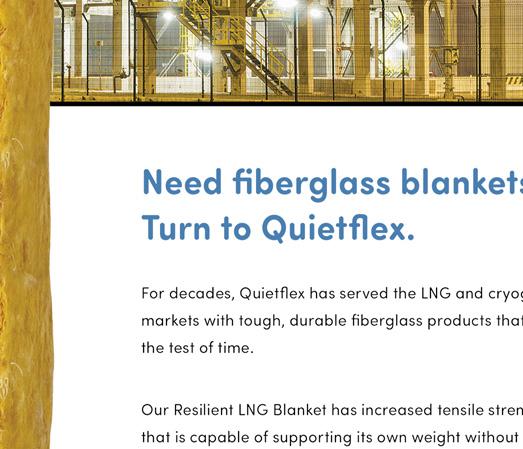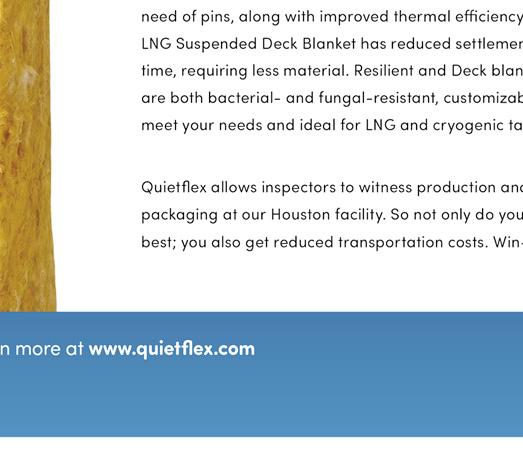
12 minute read
Versatility, key for a changing world




The energy industry is on the verge of profound changes. A growing awareness exists regarding the necessity to move towards greener solutions. This means the widespread adoption of renewables in the long run, as well as all possible measures to reduce the carbon footprint from already established energy sources: replacing coal with gas and by integrating carbon capture and storage (CCS) projects within the already established energy market.
The same applies to the maritime sector. Whether it is gas bulkers, gas carriers, tankers, container ships, or smaller cruise vessels and ferries, the sector is under pressure to decrease greenhouse gas (GHG) emissions. On an international basis, the regulatory framework relies mainly on the International Convention for the Prevention of Pollution from Ships (MARPOL), one of the three key conventions from the International Maritime Organization (IMO) together with SOLAS and STCW. MARPOL’s Annex VI relating to the ‘Prevention of Air Pollution from Ships’, which came into force in 2005, regulating primarily SOx, NOx, and particulate matter emissions reduction, was amended by the Marine Environment Protection Committee (MEPC 62/24) in 2011. A dedicated chapter has been added, regulating energy efficiency for ships and consequently ruling on GHG emissions reductions on ships of 400 t and above. Through this new chapter, two main mechanisms were introduced. Firstly, the Energy Efficiency Design Index (EEDI) setting goals on ships’ carbon intensity reductions through reduction factors. Secondly, the Ship Energy Efficiency Management Plan (SEEMP) was set up to create requirements and traceability of continued performance optimisation. MEPC 72, held in 2019, adopted the initial IMO GHG strategy envisaging a reduction in carbon intensity by transport of at least 40% by 2030 and 70% by 2050. Total annual GHG emissions from international shipping must also be reduced by 50% by 2050 compared to 2008 levels (Figure 1). Within the outcomes of the last MEPC 76 held in June 2021, the requirements and certifications for existing vessels, the efficiency indexes for existing vessels (EEXI), and the Carbon Intensity Indicator (CII) are set to come into force from January 2023.
Wind assisted propulsion (WASP), hull air lubrication, electrification, and operational profile optimisation through digitalisation can be put into service, but the most important change for the coming years seems to be fuel diversification by replacing conventional oil-based fuels with liquefied gases. LNG, ammonia, and hydrogen are such candidates to fulfil this role, with LNG being the most promising in the short-term.
In this context of rapid changes and uncertainties about the best fuel alternatives, the versatility of vessels towards different liquefied gases is essential in supporting owners to comply with regulations. Many players have taken the lead. From gas handling equipment to engine makers, the industry is striving to develop multi-gas solutions with minimum modifications or no retrofit. Gas storage tanks are an important part of a vessel, as they are generally difficult to retrofit and represent a significant part of vessel cost.
Different tank solutions are available from atmospheric Type A, B, and membrane technologies, to pressurised Type C tanks. For many decades, membrane tanks have been the preferred technology applied on LNG carriers. For LNG fuelled vessels, membrane containment systems are being increasingly applied, especially to large containerships, cruise ships, and bunker vessels. Membrane tanks on liquefied gas fuelled vessels offer optimised space utilisation, lower weight, cost, and boil-off rate (BOR) when compared to self-supporting tank technologies. With the aim of assuring shipowners that there will still be fuel versatility when taking advantage of




Ezequiel Orlandi and Emmanuel Rousseau, GTT, France, detail the maritime industry’s available options for contributing to a more sustainable world.







membrane systems, much development work has been undertaken to drive membrane tanks to the industry as being the most multi-gas compatible technology on the market.
Fostering ammonia-ready vessels
Ammonia was recently the subject of a compatibility study by GTT. Material compatibility is one of the challenges when considering ammonia storage. One of the advantages of the Mark III system is its stainless steel (304 L) primary barrier that is fully compatible with ammonia according to the IGC code. This is much more complicated for self-supporting tanks such as Type A, B, or C, as the most commonly used material to date – 9% nickel steel – is not fully compatible. For such tanks, compatibility is thus only achieved by using much more expensive materials such as stainless steel or aluminium.
Through the work GTT has undertaken, the company has obtained Bureau Veritas’ (BV) Approval in Principle (AiP) for the ‘NH3 Ready’ notation applied to the Mark III technology. The notation makes Mark III membrane the only ‘real’ NH3 ready technology for any type of LNG fuelled vessel, providing shipowners with required flexibility towards ammonia fuel gas solutions. The AiP recognises that Mark III membrane technology is suitable to contain ammonia without significant retrofit, offering shipowners the possibility to operate their ships on LNG and to convert them later to ammonia with limited additional cost related to major tank workover. In addition to the assessed membrane material suitability, the compatibility study also evaluated increased sloshing loads expected when using ammonia. The increased liquefied ammonia density (680 kg/m3) was carefully analysed by GTT’s extensive background and proven research excellence on liquid motion studies. Finally, great care has been paid to evaluate leakage management philosophy, due to the toxic nature of ammonia. Indeed, a membrane system offers a high safety level as a result of its double liquid-tight barriers, the insulation space pressurisation philosophy, and the constant gas monitoring.
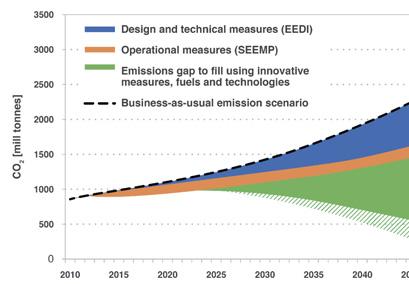
Figure 1. Overall greenhouse gas (GHG) reduction pathway assumed by IMO GHG strategy to cut CO2 emissions. Gap from business-as-usual to be filled with innovative technologies and other targets to be met by optimising design and operational indexes. Source: International Maritime Organization.
Figure 2. Le Commandant Charcot, the very first polar cruise vessel using LNG as fuel, fitted with two membrane fuel tanks (total capacity of 4500 m3) designed to 2 bar gauge. Image courtesy of Ponant.

Increasing design pressure and flexibly
Membrane cargo tanks have a maximum design pressure of 0.7 bar gauge in accordance with the IGF1 code. Although this standard is compatible with the LNG supply chain, a higher design pressure is desirable for increased operational flexibility. Indeed, higher design pressure increases gas holding time with a consequent greater resilience on managing boil-off as well as providing better optimisation towards different operations (idling, bunkering, loading, cooling-down, etc). Higher design pressure allows easier handling of LNG with increased saturation pressure (warmer LNG). The IGF code (section 2.3) gives the possibility of deviating from already prescribed requirements as long as the alternative solution meets the same functional requirements and a safety level not lower than the one already prescribed by code. Alternative designs are also supported by SOLAS II-1/55 (MSC.1/Circ. 1455 and MSC.1/Circ. 1212).
As a result, through a very unique project, the Commandant Charcot from Ponant, the first polar cruise explorer fuelled by LNG, GTT has worked on a 1 bar gauge tank design pressure solution with tanks fitted with a specially reinforced combined liquid/gas dome. Through this development work, in February 2021 GTT received an AiP from BV for a tank design pressure of 1 bar gauge for Mark III for LNG as fuel applications. The vessel was also granted approval for tank maximum working pressure of 2 bar gauge for bunkering and under emergency situations. Increased pressure while bunkering assures greater compatibility with bunker vessels fitted with Type C tanks, reducing unnecessary flaring. It also allows decreased bunkering duration without the need of oversizing fuel gas handling equipment to manage boil-off gas (BOG) while bunkering. Higher operating pressure during emergency situations also contributes to meeting IGF’s holding time requirement of a minimum of 15 days with cargo tanks fully loaded at ship idle conditions with only BOG consumption on hotel load. Increased pressures for such unique passenger vessels also provide greater margin for operators and increases safety during emergency shutdown (ESD) and safe return to port (SRtP) situations.
Mark III membrane tanks have recently completed another major milestone by receiving an AiP from DNV. The AiP is based on assessments of safety equivalence not only for the containment system, but also the fuel gas handling

Figure 3. CMA CGM JACQUES SAADE, the first 23 000 TEU containership fuelled by LNG fitted with one 18 600 m3 Mark III membrane fuel tank. Image courtesy of CMA CGM.
Figure 4. SERI EVEREST the world’s largest VLEC (98 156 m3) to be granted ABS notation ‘LNG Cargo Ready’ contributing to ethane market development and opening perspectives for ultra large ethane carrier designs. Image courtesy of MISC.
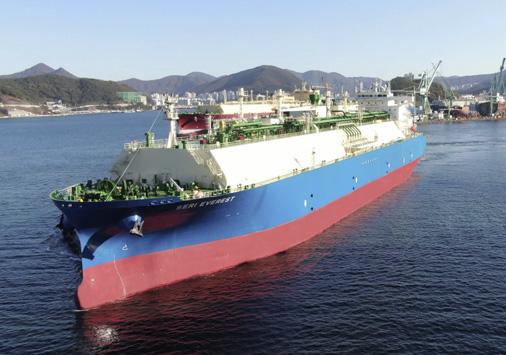
equipment and the hull structure subject to increased loads. This technical analysis was then further evaluated against its implications under normal and downgraded operating conditions. Through this work, GTT is able to offer such flexible solutions to many types of LNG-fuelled vessels, from cruise vessels to car carriers and container feeders.
Versatility supporting gas market development
Besides being the fuel of choice on maritime vessels, the evolution of some gas markets with the potential of decreasing the carbon footprint also relies to a large extent on gas bulkers’ versatility. This is the case for the ethylene production chain, which is nowadays mainly based on naphtha. The emergent and increasing use of ethane, since the US shale revolution, offers the possibility of greener ethane to ethylene only crackers. However, as a niche market, some issues shall be addressed to assure shipowners of cargo flexibility. For instance, by the creation of the ‘LNG Cargo Ready’2 notation in a joint project with ABS, GTT provides a way for the capacity increase on ethane carriers to be achieved. The notation is already applied to the last generation of very large ethane-LPG carrier identified as one of the greatest ships of 2020. The notation was applied to the cargo tanks (mandatory) but also for pumps, the fuel gas supply system, and the main engine. Taking advantage of this experience and the offer from equipment makers, 150 000 m3 ethane carriers are now on the drawing board for ethane carriers which are also compatible with LNG. An ethane carrier, which can be adapted beforehand to handle LNG, presents itself as a significant advantage within a growing and diversifying small to mid scale LNG market, giving shipowners the opportunity to make the most of the freight market as it evolves. Operations not only as a midsize LNG carrier, but also as a floating storage unit (FSU) or even floating storage and regasification unit (FSRU) can be envisaged. The exact implications of the notation and its real value will be proved in the coming years, through the second and third generations of VLECs and possibly the very first 150 000 m3 ultra large ethane carrier (ULEC). In the meantime, GTT continues to anticipate and to provide support for the shipping market segments willing to acquire this innovative notation, bringing value and flexibility to all players.
A collective effort: a communication challenge
To tackle the challenge of decarbonisation and meet an ever more stringent pollution restriction in a very short time, the maritime industry requires innovation more than ever. As vessels are composed of intrinsically related systems, innovations from all system providers need to be well harmonised. As the tanks are a key piece of equipment in any liquefied gas carrier or fuelled vessel, GTT has kept its innovative spirit extending and diversifying applications of its membrane containment systems in the hope of accelerating and triggering innovations from other industry actors. Besides the innovations related to versatility towards greener fuels and optimised operating conditions through increased tank design pressures, GTT has also taken advantage of its extensive know-how on oceangoing vessel operating profiles. Its knowledge in liquid motion studies also enables the development of digital platforms which are aligned with the initial IMO GHG strategy. This is the case of LNG Optim™ which has been designed to help shipowners to reduce emissions and improve operational economics.
GTT is able to assure best efficiency in relation to boil-off management thanks to complex algorithms also taking environmental conditions and sea states into account. Another example of a digital platform, the Sloshing Virtual Sensor, combines IoT, powerful onboard data acquisition, and AI. This digital solution enables the prediction of sloshing frequency and pressures and can have a positive impact on predicting maintenance (decreasing downtime). It substantially increases operability limits (mainly for FLNGs and FSRUs) and helps liquefied gas fuelled vessels to manage partial fillings together with keeping safe levels for fuel gas pumps operations.
Through technical and digital innovations, GTT focuses on developing technology for a sustainable world.
References
1. International Code of Safety for Ships Using Gases or Other
Low-flashpoint Fuels. 2. American Bureau of Shipping, ‘LNG Cargo Ready Vessels’,
September 2019.
